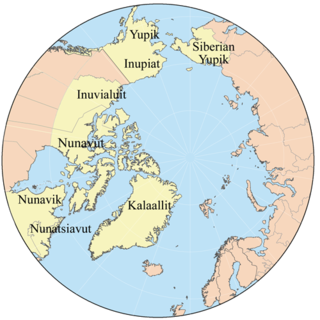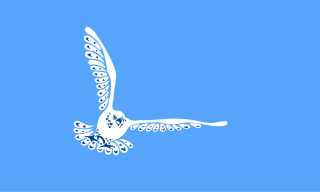Related Research Articles

Eskimo is an exonym used to refer to two closely related Indigenous peoples: the Inuit and the Yupik of eastern Siberia and Alaska. A related third group, the Aleut, which inhabit the Aleutian Islands, are generally excluded from the definition of Eskimo. The three groups share a relatively recent common ancestor, and speak related languages belonging to the Eskaleut language family.

The Northwest Territories is a federal territory of Canada. At a land area of approximately 1,144,000 km2 (442,000 sq mi) and a 2016 census population of 41,790, it is the second-largest and the most populous of the three territories in Northern Canada. Its estimated population as of 2023 is 45,668. Yellowknife is the capital, most populous community, and only city in the territory; its population was 19,569 as of the 2016 census. It became the territorial capital in 1967, following recommendations by the Carrothers Commission.

Northern Canada, colloquially the North or the Territories, is the vast northernmost region of Canada variously defined by geography and politics. Politically, the term refers to the three territories of Canada: Yukon, Northwest Territories and Nunavut. This area covers about 48 per cent of Canada's total land area, but has less than 0.5 per cent of Canada's population.

Aklavik is a hamlet located in the Inuvik Region of the Northwest Territories, Canada. Until 1961, with a population over 1,500, the community served as the regional administrative centre for the territorial government.
Inuvialuktun comprises several Inuit language varieties spoken in the northern Northwest Territories by Canadian Inuit who call themselves Inuvialuit. Some dialects and sub-dialects are also spoken in Nunavut.

Inuinnaqtun, is an Inuit language. It is spoken in the central Canadian Arctic. It is related very closely to Inuktitut, and some scholars, such as Richard Condon, believe that Inuinnaqtun is more appropriately classified as a dialect of Inuktitut. The government of Nunavut recognises Inuinnaqtun as an official language in addition to Inuktitut, and together sometimes referred to as Inuktut. It is also spoken in the Northwest Territories and is also recognised as an official language in addition to Inuvialuktun and Inuktitut.

The Inuvialuit or Western Canadian Inuit are Inuit who live in the western Canadian Arctic region. They, like all other Inuit, are descendants of the Thule who migrated eastward from Alaska. Their homeland – the Inuvialuit Settlement Region – covers the Arctic Ocean coastline area from the Alaskan border, east through the Beaufort Sea and beyond the Amundsen Gulf which includes some of the western Canadian Arctic Islands, as well as the inland community of Aklavik and part of Yukon. The land was demarked in 1984 by the Inuvialuit Final Agreement.
The Anderson River is in the Northwest Territories in northern Canada. It originates in lakes northwest of Great Bear Lake; its headwaters are possibly on the north side of Colville Lake in the vicinity of the hamlet of Colville Lake. It flows north and west in the area between the Mackenzie and Coppermine Rivers. Its mouth is on the Beaufort Sea on the Arctic Ocean near the eastern end of Liverpool Bay at about 70 degrees north latitude. Its main tributary is the Carnwath River. Originally known as the Beghula River it was renamed to the Anderson River in 1857 by Roderick MacFarlane after James Anderson, both of the Hudson's Bay Company. Anderson was the Chief Factor in the Mackenzie District.

Sallirmiutun is the dialect of Inuvialuktun spoken by the Siglit, an Inuit group of the Northwest Territories, Canada. It is mainly used in the Inuvialuit communities of Paulatuk, Sachs Harbour and Tuktoyaktuk. Sallirmiutun was once the principal dialect of the Mackenzie River delta, nearby parts of the coast and Arctic Ocean islands, but the number of speakers fell dramatically following outbreaks of new diseases in the 19th century and for many years Sallirmiutun was believed to be completely extinct. It was only in the 1980s that outsiders realised that it was still spoken.

Uummarmiutun, Uummaġmiutun or Canadian Iñupiaq is the variant of Iñupiaq spoken by the Uummarmiut, part of the Inuvialuit, who live mainly in the communities of Inuvik and Aklavik in the Northwest Territories of Canada.

Ulukhaktok is a small hamlet on the west coast of Victoria Island, in the Inuvik Region of the Northwest Territories, Canada.

The Nunamiut or Nunatamiut are semi-nomadic inland Iñupiat located in the northern and northwestern Alaskan interior, mostly around Anaktuvuk Pass, Alaska.

Inuit are a group of culturally similar Indigenous peoples inhabiting the Arctic and subarctic regions of Greenland, Labrador, Quebec, Nunavut, the Northwest Territories, and Alaska. Inuit languages are part of the Eskimo–Aleut languages, also known as Inuit-Yupik-Unangan, and also as Eskaleut. Inuit Sign Language is a critically endangered language isolate used in Nunavut.

Copper Inuit, also known as Inuinnait and Kitlinermiut, are a Canadian Inuit group who live north of the tree line, in what is now the Kitikmeot Region of Nunavut and in the Inuvialuit Settlement Region in the Inuvik Region of the Northwest Territories. Most of them historically lived in the area around Coronation Gulf, on Victoria Island, and southern Banks Island.

The Kangiryuarmiut are an Inuvialuit group, culturally and historically related to the Copper Inuit. They were historically located on Victoria Island in the areas of Prince Albert Sound, Cape Baring, and central Victoria island. They often travelled seasonally around their traditional territory including to Banks Island, both south to Nelson Head and as far north as Mercy Bay to collect raw materials from the wreck of HMS Investigator. Archaeologists have also found many sites left by Kangiryuarmiut and their ancestors in what is now Aulavik National Park. Today, many Kangiryurmiut still live on Victoria Island, in the hamlet of Uluhaktok, now within the Inuvialuit Settlement Region.

The Inuvialuit Settlement Region, abbreviated as ISR, located in Canada's western Arctic, was designated in 1984 in the Inuvialuit Final Agreement by the Government of Canada for the Inuvialuit people. It spans 90,650 km2 (35,000 sq mi) of land, mostly above the tree line, and includes several subregions: the Beaufort Sea, the Mackenzie River delta, the northern portion of Yukon, and the northwest portion of the Northwest Territories. The ISR includes both Crown Lands and Inuvialuit Private Lands.
Hugh Brody is a British anthropologist, writer, director and lecturer.

Inuit Nunangat is the homeland of the Inuit in Canada. This Arctic homeland consists of four northern Canadian regions called the Inuvialuit Settlement Region, the territory Nunavut (ᓄᓇᕗᑦ), Nunavik (ᓄᓇᕕᒃ) in northern Québec, and Nunatsiavut of Newfoundland and Labrador.

The Indigenous peoples of Yukon are ethnic groups who, prior to European contact, occupied the former countries now collectively known as Yukon. While most First Nations in the Canadian territory are a part of the wider Dene Nation, there are Tlingit and Métis nations that blend into the wider spectrum of indigeneity across Canada. Traditionally hunter-gatherers, indigenous peoples and their associated nations retain close connections to the land, the rivers and the seasons of their respective countries or homelands. Their histories are recorded and passed down the generations through oral traditions. European contact and invasion brought many changes to the native cultures of Yukon including land loss and non-traditional governance and education. However, indigenous people in Yukon continue to foster their connections with the land in seasonal wage labour such as fishing and trapping. Today, indigenous groups aim to maintain and develop indigenous languages, traditional or culturally-appropriate forms of education, cultures, spiritualities and indigenous rights.

References
- ↑ IRC. "COPE". Inuvialuit Regional Corporation. Retrieved October 15, 2022.
{{cite web}}: CS1 maint: url-status (link) - ↑ Morrison, David. "The Inuvialuit (in detail)". Civilization. Retrieved October 15, 2022.
{{cite web}}: CS1 maint: url-status (link) - ↑ Petitot, Emile (1878). Monographie des Esquimaux Tchiglit du Mackenzie et de l’Anderson. Paris: Ernest Leroux. ISBN 9780259035787.
- ↑ Arnold, Charles (2016). "The Development of the Mackenzie Inuit Culture". In Mason, Owen (ed.). The Oxford Handbook of Arctic Archaeology. Oxford: Oxford University Press.